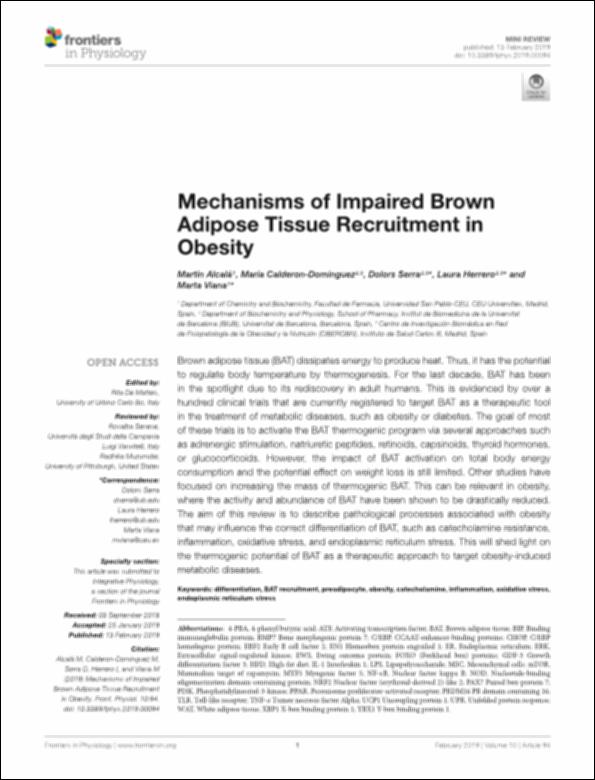Please use this identifier to cite or link to this item:
http://hdl.handle.net/10637/14547Mechanisms of Impaired Brown Adipose Tissue Recruitment in Obesity
| Title: | Mechanisms of Impaired Brown Adipose Tissue Recruitment in Obesity |
| Authors : | Alcalá Díaz-Mor, Martín Calderón Domínguez, María Serra, Dolors Herrero Rodríguez, Laura Viana Arribas, Marta |
| Keywords: | Differentiation; BAT recruitment; Preadipocyte; Obesity; Catecholamine; Inflammation; Oxidative stress; Endoplasmic reticulum stress |
| Publisher: | Frontiers |
| Citation: | Alcalá M, Calderon-Dominguez M, Serra D, Herrero L and Viana M (2019) Mechanisms of Impaired Brown Adipose Tissue Recruitment in Obesity. Front. Physiol. 10:94. doi: 10.3389/fphys.2019.00094 |
| Abstract: | Brown adipose tissue (BAT) dissipates energy to produce heat. Thus, it has the potential to regulate body temperature by thermogenesis. For the last decade, BAT has been in the spotlight due to its rediscovery in adult humans. This is evidenced by over a hundred clinical trials that are currently registered to target BAT as a therapeutic tool in the treatment of metabolic diseases, such as obesity or diabetes. The goal of most of these trials is to activate the BAT thermogenic program via several approaches such as adrenergic stimulation, natriuretic peptides, retinoids, capsinoids, thyroid hormones, or glucocorticoids. However, the impact of BAT activation on total body energy consumption and the potential effect on weight loss is still limited. Other studies have focused on increasing the mass of thermogenic BAT. This can be relevant in obesity, where the activity and abundance of BAT have been shown to be drastically reduced. The aim of this review is to describe pathological processes associated with obesity that may influence the correct differentiation of BAT, such as catecholamine resistance, inflammation, oxidative stress, and endoplasmic reticulum stress. This will shed light on the thermogenic potential of BAT as a therapeutic approach to target obesity-induced metabolic diseases. |
| URI: | http://hdl.handle.net/10637/14547 |
| Rights : | http://creativecommons.org/licenses/by-nc-nd/4.0/deed.es openAccess |
| Issue Date: | 13-Feb-2019 |
| Center : | Universidad San Pablo-CEU |
| Appears in Collections: | Facultad de Farmacia |
Items in DSpace are protected by copyright, with all rights reserved, unless otherwise indicated.


